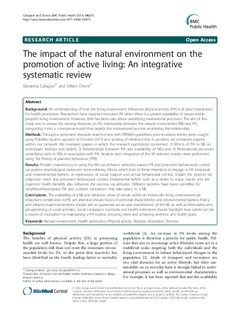| dc.contributor.advisor | | |
| dc.contributor.author | Calogiuri, Giovanna | |
| dc.contributor.author | Chroni, Stiliani | |
| dc.date.accessioned | 2014-11-18T08:39:42Z | |
| dc.date.available | 2014-11-18T08:39:42Z | |
| dc.date.issued | 2014-08-24 | |
| dc.identifier.citation | Calogiuri, G. & Chroni. S. (2014). The impact of the natural environment on the promotion of active living: An integrative systematic review. BMC Public Health, 14:873. doi: http://dx.doi.org/10.1186/1471-2458-14-873 | nb_NO |
| dc.identifier.issn | 1471-2458 | |
| dc.identifier.uri | http://hdl.handle.net/11250/226138 | |
| dc.description | This is an Open Access scientific, peer-reviewed article originally published in the journal BMC Public Health. The article can be accessed at the following location: http://www.biomedcentral.com/bmcpublichealth/. It is published under the Creative Commons Attribution License 4.0. Please consult http://www.biomedcentral.com/about/license. | nb_NO |
| dc.description.abstract | Background: An understanding of how the living environment influences physical activity (PA) is of great importance for health promotion. Researchers have reported increased PA when there is a greater availability of nature within people’s living environment. However, little has been said about underlying motivational processes. The aim of this study was to review the existing literature on the relationship between the natural environment (NE) and PA, integrating it into a conceptual model that depicts the motivational process underlying this relationship.
Methods: Through a systematic literature search in line with PRISMA guidelines, peer-reviewed articles were sought using PubMed (search updated to October 2013) and scrutiny of reference lists. In addition, we contacted experts within our network. We reviewed papers in which the research question(s) concerned: 1) Effects of PA in NE on
individuals’ feelings and beliefs; 2) Relationships between PA and availability of NEs; and 3) Motivational processes underlying visits to NEs in association with PA. Analysis and integration of the 90 selected studies were performed using the theory of planned behaviour (TPB).
Results: People’s experiences in using the NE can enhance attitudes toward PA and perceived behavioural control via positive psychological states and stress-relieving effects,which lead to firmer intentions to engage in PA. Individual and environmental barriers, as expressions of social supp ort and actual behavioural control, impact the process via subjective norm and perceived behavioural control. Instrumental beliefs such as a desire to enjoy nature and the expected health benefits also influence the process via attitudes. Different patterns have been identified for neighbourhood-based PA and outdoor recreations that take place in a NE.
Conclusions:The availability of a NE and attractive views of nature within an individual’s living environment are important contributors to PA, yet attention should focus on personal characteristics and environmental barriers. Policy and infrastructural interventions should aim to guarantee access and maintenance of the NE, as well as information and programming of social activities. Social campaigns via media and health institutions should highlight how nature can be a source of motivation for maintaining a PA routine, reducing stress and achieving aesthetic and health goals.
Keywords: Natural environment, Health promotion, Physical activity, Attitude, Motivation, Exercise | nb_NO |
| dc.language.iso | eng | nb_NO |
| dc.publisher | BioMed Central | nb_NO |
| dc.relation.uri | http://www.biomedcentral.com/ | |
| dc.subject | natural environment | nb_NO |
| dc.subject | health promotion | nb_NO |
| dc.subject | physical activity | nb_NO |
| dc.subject | attitude | nb_NO |
| dc.subject | motivation | nb_NO |
| dc.subject | exercise | nb_NO |
| dc.subject.mesh | Attitude | |
| dc.subject.mesh | Environment | |
| dc.subject.mesh | Environment Design | |
| dc.subject.mesh | Exercise | |
| dc.subject.mesh | Health Behavior | |
| dc.subject.mesh | Health Promotion | |
| dc.subject.mesh | Motivation | |
| dc.subject.mesh | Residence Characteristics | |
| dc.title | The impact of the natural environment on the promotion of active living: An integrative systematic review | nb_NO |
| dc.type | Journal article | nb_NO |
| dc.type | Peer reviewed | nb_NO |
| dc.subject.nsi | VDP::Medical disciplines: 700::Health sciences: 800 | nb_NO |
| dc.source.volume | 14 | nb_NO |
| dc.source.journal | BMC Public Health | nb_NO |
| dc.source.issue | 873 (article number) | nb_NO |
| dc.identifier.doi | http://dx.doi.org/10.1186/1471-2458-14-873 | |
